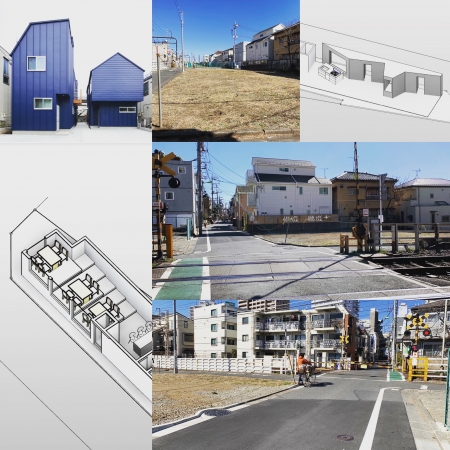土地とのつながり
地面との接触面を意識して見え方を考えている。
建築は地面の上に載り、必ず地面との接触面ができるので、土地とのつながりが必然的にできてしまい、土地に縛られる、土着的な、リージョナルな建築を生み出すことになる。そこで、モダニズム建築では意識的に地面から離すことで、建築をインターナショナルなものにしようとした。その代表的な手法がピロティであり、地面から持ち上げ、切り離すことで土地とのつながりを断ち、土地と建築の間に新たな空間を差し込んだ。コルビュジエはそのピロティを多用し、新たなにできた空間を都市に寄与する交通空間として捉えていた。
地面から建築を切り離す行為は、建築をインターナショナルかリージョナルかの両極端で考えようとした時の副産物であるので、ピロティにはある種の清さを感じるが、同時にピロティには古臭さも感じるので、建築をインターナショナルかリージョナルかの両極端で考えること自体が現代では古臭く、的外れなのだろう。
接触でも無く、切り離しでも無い状態をつくり出すことができれば、新たな見え方が獲得できる。
"Connection with the land"
I am thinking about how to see it, paying attention to the contact surface with the ground.
Since the architecture rests on the ground and always has a contact surface with the ground, it inevitably creates a connection with the land, creating an indigenous, regional architecture that is tied to the land. Therefore, in modernist architecture, I tried to make the architecture international by consciously moving it away from the ground. A typical method is piloti, which breaks the connection with the land by lifting it from the ground and separating it, and inserts a new space between the land and the building. Le Corbusier made heavy use of the piloti and regarded the newly created space as a transportation space that contributes to the city.
The act of separating architecture from the ground is a by-product of trying to think of architecture at the extremes of international and regional, so the piloti feels some kind of cleanliness, but at the same time, the piloti also feels old-fashioned, so architecture. It seems that thinking at the extremes of international and regional is old-fashioned and irrelevant in modern times.
If we can create a state that is neither contact nor separation, we can acquire a new appearance.


